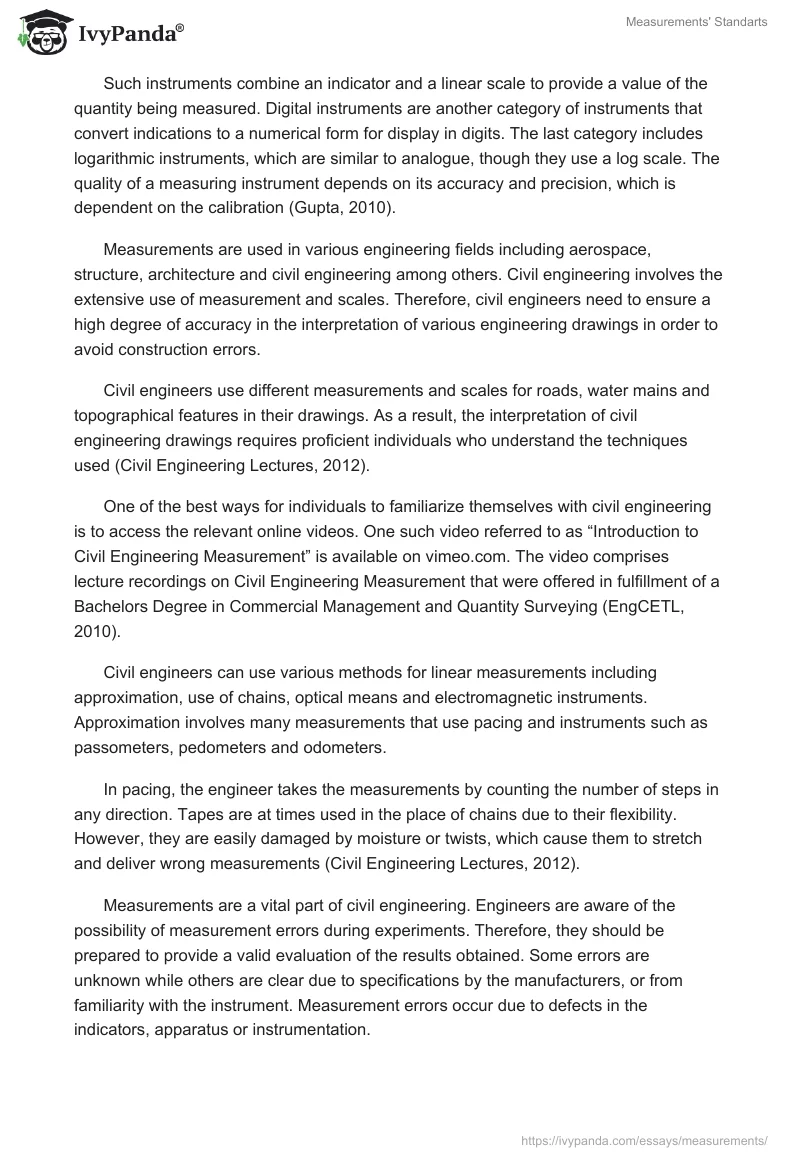Measurement refers to the process of determining the proportion of a physical quantity such as temperature, time, volume, area, weight and length. Measurement of length involves determination of the distance between two points. The measurement of temperature involves the quantification of how hot or cold a substance is in Kevin.
Measurement of volume determines the capacity of matter, while weight determines how heavy the object is. Measurement is an arbitrary unit or value. As a result, early human beings came up with measurement units so that some order could be achieved in quantifying matter (Gupta, 2010).
Measurement was one of the first logical achievements of man, which allowed people to count and carry out basic calculations. Early humans used various materials to construct implements that defined standards for measurement. Other units of early measurement used body parts such as fingers, arms and feet.
The Chinese, Egyptians, Greeks and Romans used measurements that were accepted by their people, though there were no standards. A standard system of weights and measures was established in the early nineteenth century after numerous consultations between mathematicians, geodesists, and physicists (Gupta, 2010).
The international bureau of standards was set up in Paris in 1875, and later revised in 1960 to form the new International System of Units.(SI). Establishment of the same standards of measurement made it easier for scientists and engineers to communicate with each other. The SI work by combining prefixes and base units to define the magnitude of the quantities. The five common base units are the meter (m), kilogram (kg), second (s), Kelvin (K) and the mole (mol) (Gupta, 2010).
Engineers use a variety of instruments to obtain different measurements. For instance, scales and gauges measure length, thermometers and thermocouples measure temperature, and piezometers measure pressure. Scientists use other instruments to measure force, electricity, air speed and humidity. Instruments are used to determine measurements in different ways. Analogue instruments indicate a physical proportion of the quantity being measured.
Such instruments combine an indicator and a linear scale to provide a value of the quantity being measured. Digital instruments are another category of instruments that convert indications to a numerical form for display in digits. The last category includes logarithmic instruments, which are similar to analogue, though they use a log scale. The quality of a measuring instrument depends on its accuracy and precision, which is dependent on the calibration (Gupta, 2010).
Measurements are used in various engineering fields including aerospace, structure, architecture and civil engineering among others. Civil engineering involves the extensive use of measurement and scales. Therefore, civil engineers need to ensure a high degree of accuracy in the interpretation of various engineering drawings in order to avoid construction errors.
Civil engineers use different measurements and scales for roads, water mains and topographical features in their drawings. As a result, the interpretation of civil engineering drawings requires proficient individuals who understand the techniques used (Civil Engineering Lectures, 2012).
One of the best ways for individuals to familiarize themselves with civil engineering is to access the relevant online videos. One such video referred to as “Introduction to Civil Engineering Measurement” is available on vimeo.com. The video comprises lecture recordings on Civil Engineering Measurement that were offered in fulfillment of a Bachelors Degree in Commercial Management and Quantity Surveying (EngCETL, 2010).
Civil engineers can use various methods for linear measurements including approximation, use of chains, optical means and electromagnetic instruments. Approximation involves many measurements that use pacing and instruments such as passometers, pedometers and odometers.
In pacing, the engineer takes the measurements by counting the number of steps in any direction. Tapes are at times used in the place of chains due to their flexibility. However, they are easily damaged by moisture or twists, which cause them to stretch and deliver wrong measurements (Civil Engineering Lectures, 2012).
Measurements are a vital part of civil engineering. Engineers are aware of the possibility of measurement errors during experiments. Therefore, they should be prepared to provide a valid evaluation of the results obtained. Some errors are unknown while others are clear due to specifications by the manufacturers, or from familiarity with the instrument. Measurement errors occur due to defects in the indicators, apparatus or instrumentation.
Since precision involves repeatability of the result and accuracy involves proximity to the true value, the two terms can be used to evaluate the behavior of measuring devices. They can be precise and accurate, precise and inaccurate, imprecise and accurate, or imprecise and inaccurate. It is up to the engineer to determine the error in the measurements, and take the necessary corrective measures for precision in the work (Civil Engineering Lectures, 2012).
Developments in civil engineering measurements allow for the easy identification of systematic errors and provide guidelines for compensation or correction. There are also developments for correcting random errors using statistical methods (Civil Engineering Lectures, 2012).
References
Civil Engineering Lectures. (2012). Methods of Linear Measurements. Web.
EngCETL (Director). (2010). Introduction to Civil Engineering Measurement.
Gupta, S.V. (2010). Units of measurement: Past, present and future. International Systems of Units. New York: Springer Series in Material Science.


